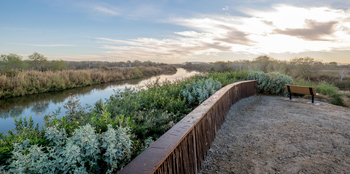To improve the riverfront parks, the Heritage Area recently received a $250,000 grant from the Arizona Office of Tourism and is collaborating with the city’s Parks and Recreation Department to make landscape and parking improvements in the center of West Wetlands Park.
The organization assembled more than $400,000 in grant funds to build a small nature park at the East Wetlands, just north of the PAAC. Ground work will begin on these projects within the next few months.
The Heritage Area also provides educational programming for school children, both in the classroom and via field trips. For the past two years, the organization has received funding from the National Park Foundation to bring Yuma County fourth graders to the state parks and East Wetlands for educational and interactive field trips, all at no cost to the schools.
This program includes an educational video series produced by staff and narrated by mascots Ranger Bucky and Yasmin the Yellow-billed cuckoo.
“We should find out within the next week or two if our next grant application is awarded, allowing us to continue this program which has become very popular with Yuma County schools,” Halligan said.
The Heritage Area also sponsors several cultural events held at the state parks including the popular Dia de los Muertos event and the new Asian and Pacific Islander cultural event Haru Matsuri, which received “great” attendance this past spring.
The Heritage Area also collaborates with other entities to host various youth programming like National Space Day, the recent Exploration Station events, and the Christmas on the Colorado event.
These events were “well attended by the public and becoming more and more popular,” she noted.
The Heritage Area collaborated with KAWC Public Radio to hold concerts at the Colorado River State Historic Park, and it hopes to continue this relationship.
Both parks also serve as venues for private events. The Penitentiary Pint Fest was held at the Yuma Territorial Prison, and Harvest Dinner takes place at the Colorado River park annually.
In addition, the Colorado River park is rented nearly every weekend for weddings and special events during the fall and winter.
The Heritage Area strives to regularly improve the visitor experience through new exhibit development at the parks. A couple of years ago, the organization introduced passes to the Yuma state parks “to make it more affordable for local community members to visit our parks multiple times throughout the year.”
A family pass is just $50 a year for entry into both parks. “So if you haven’t visited the state parks in a while, we hope you’ll help support these treasured historic assets and come out and see what’s new,” Halligan said.
“Yuma has so much to offer, but we continually receive comments from first-time visitors that they didn’t know all of this existed in Yuma,” she noted.
The Heritage Area, in conjunction with Visit Yuma, is working to change that. “Continuing to promote Yuma as a tourist destination is a high priority for us, and we’re excited to see results from Visit Yuma’s new marketing campaign,” Halligan added.


